The brief spell of rains this morning had drenched the roads, settlement, port and jetties of Port Blair. Surrounding the jetty, the buildings look freshly painted and the trees have adorned a rich green colour. I reach the Phoenix Bay jetty a couple of hours before the scheduled departure of my ferry to the Havelock Island, the second most visited place in the Andamans after Port Blair. As if boarding an aircraft, the jetty operations of such inter-island ferries are professionally managed that involve fine bit of security clearance. My ferry, a privately owned small cruise, is scheduled at 1255hrs sharp and the boarding, they say, will commence just a few minutes before that.

Passengers inside the hall waiting for their ferry to arrive at the jetty. More images at Flickr

And the Makruz – a privately managed catamaran cruise service – ferry arrives. More at Flickr
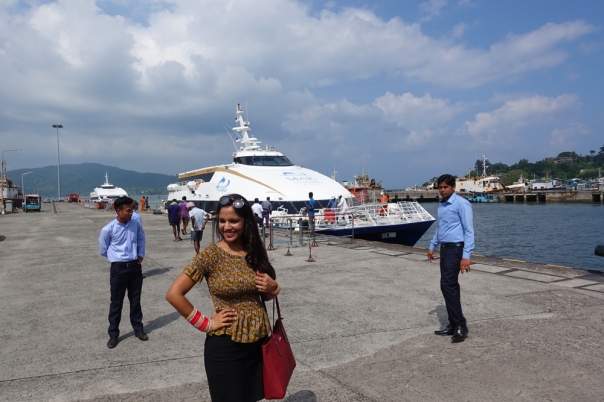
Most passengers comprises either first time holiday makers or honeymooners. More images at Flickr

The sitting arrangement inside the ferry. Please visit Flickr for more images of the region
As the ferry arrives, the stewards quickly ushers us to our respective seats. The ferry, a catamaran has comfortable seats with a nearly soundproof compartment. Flat screens that play Bollywood songs dot the interiors. Soon, the boat leaves the jetty. The spectacular seascape is visible through large tinted glass windows but the travellers are prohibited from stepping on the deck outside the air-conditioned compartment. From the waters, the Andamans appear lush green. With every inch of soil studded with trees and shrubbery, the islands protrude like young hills above the blue water. Small untouched beaches interspersed with mangroves outline the greenery. The boat is floating gently out of the harbour into the deep sea, passing a few small boats. There are layers of colour on the land, deep green becoming grey and blue as they recede into the distance under a cloudy sky.
The passengers welcome the first heavy pitch of the boat with jubilation. A few minutes later, most have succumbed to sea sickness. The stewards immediately begin to distribute sickness bags. The jubilation is soon lost and nearly everyone – first time sea passengers and honeymooners – are praying for their dear life. As our vessel moves past the last sight of greenery, the pitching increases and couples with rolling. The announcements through the PA system try to keep the passengers engaged. With complete obliviousness, the crew announces that the sea is rough today and that it’s a norm. But then, most of us are witnessing the spectacle of a raging sea for the first time. With the horizon going topsy-turvy due to turbulence, our vessel is flinging in a deep sea. It climbs every roll of water landing with a huge splash.
Waves are crashing on the deck outside and onto the glass panes even as the stewards are trying their best to maintain calm inside the compartment. The sea’s fury tosses us around for nearly three hours before it finally reaches the Havelock jetty. Our catamaran, Makruz has negotiated fair bit of enormous crests and troughs to reach this island, I assume. Many passengers, mostly couples, are being helped out of the vessel at the jetty. We are in a state of both exhaustion and exhilaration after reaching Havelock. Having made landfall, almost all worries vanish for the time being. However, the very thought of having to return to Port Blair through the same route after sojourning here brings jitters.

Finally at the Havelock Jetty. Please visit Flickr for more images of the region
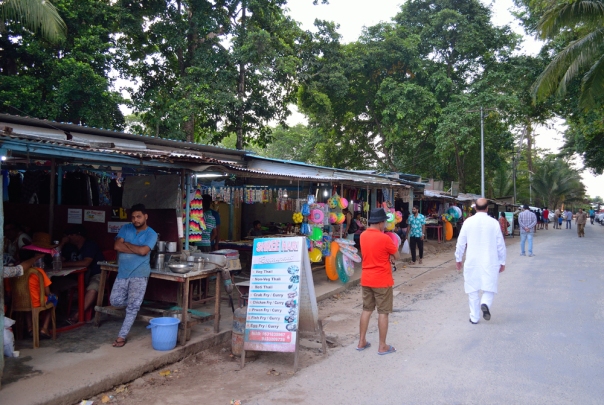
The shacks near the Radhanagar Beach. Please visit Flickr for more images of the region

The entry gate to the Radhanagar beachside. Please visit Flickr for more images of the region
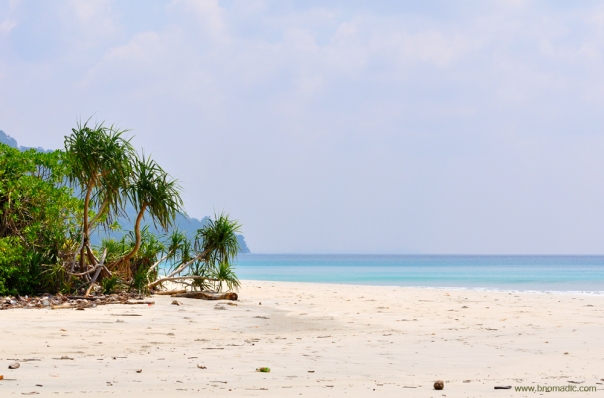
The green pandanus, a staple food of the aborigines, at Havelock. More images at Flickr
I have budgeted three nights for Havelock. A balmy evening breeze greets us at the jetty. The blue waters and the lovely weather calm everyone down. In fact, one of the most elating aspects of my sojourn in the Andamans was its climate. Seemingly controlled by a natural thermostat that regulates heat as well as cold, the islands have the same climate throughout the year. Owing to its nearness to the equator, climate extremes are non-existent here; but it rains almost eight months in a year stretching the monsoon season on both ends. The rains are often torrential and incessant. Storm, thunder and lightning almost inevitably accompany the rains. Weeklong incessant rains, which are common here also provides a solution to the potable water shortage in these islands. As the islands are densely forested, on normal days, the dusk and dawn are pleasant here. At night, the cool sea breeze refreshes the soul.
Like any other island in the Andamans, the Havelock is a captivating sight, even from several kilometres away from the sea: the rippling emerald green waves lapping gently against a sandy white beaches leading to hillocks and mounds that are rich with vegetation and tall trees covered in dense foliage; their sturdy trunks and thick barks supporting dozens of vines and other creepers. With a hundred different shades of green and blue, it seems as if someone had very artistically placed these beautiful islands in the middle of a sea. Standing tall, countless huge trees proudly hold their branches aloft leading to a serene green darkness. A row of cottages and offices are constructed on the seafront on the northeastern edge of the island close to the jetty. As shipping is the main mode of transportation to the island, the jetty remains the hub of all activities. The magnificent view of the sea in different hues of blue is spectacular from the complex.

A low-tide seascape on the northeastern edge of Havelock. More images from the region at Flickr

The Anju Coco Restaurant, Havelock Island. Please visit Flickr for more images of the region
For the next few days, I devote mornings to Kalapathar area and the evenings to Radhanagar part. The numerous cafés and eating joints that dots the island, works best for afternoon siesta. My pick is the Anju Coco Café run by a sardarji from Paharganj in Delhi. Unlike other islands of the archipelago, the settlers of Havelock are the luckiest ones as the island receives the highest number of tourists after Port Blair. Still, there are many areas and beaches on this island which are completely unoccupied and serene; fit to enjoy seclusion. To assist, the administration has also assigned number markings to all the beaches. Quite intriguingly, whereas the beaches and villages of the island have Indian names, the name of the island itself is of British origin. The reason lies in its recent history.
The Andamans are fairly new for a civilised world and many areas are yet to be named. The British wiped out aborigines from the islands to establish a penal colony as well as to secure the Bay of Bengal for themselves. The sweat and blood of the convicts are behind every permanent feature in the penal settlement of Port Blair. Tortured by the British in most cruel way, they cleared the forests to build roads, construct houses and did their best to obey the oppressors. Their labours gradually transformed the dense forests of dreaded islands into a beautiful, pleasant habitation. Gradually, as settlements came up, they were named by the British after senior administrators who were associated with Andamans in any which way or after places in the home country; or even in memory of the British generals who had helped to quell the 1857 revolt: such as Havelock Island, Sir Hugh Rose Island, Sir John Lawrence Island, Sir Henry Lawrence Island, Neill Island, Port Campbell and Aberdeen Bazaar, etcetera.

Shacks by the Kalapathar Beach. Please visit Flickr for more images of the region

Exotic fruits; I particularly liked the locally grown bananas and papayas. More images at Flickr
Initially the settlers comprised convicts but after India gained independence, refugees migrating to India were given land in and around Port Blair. When that was no longer available, they were given land in more distant places such as the Havelock Island, Middle or North Andaman. The Hindu Bengali families who migrated to India after the partition of Bengal were allotted land in the Havelock by the Government of India. The refugees named their initial settlement on the island as Govind Nagar. Subsequently all the other popular beaches and places were named by the initial settlers. Today, Havelock, the largest island of the Ritchie’s Archipelago lying east of the Great Andaman, is among the most culturally homogenous islands of the Andamans.

The Vijaynagar Beach during low tide and the exposed rocks and coral reefs. More at Flickr
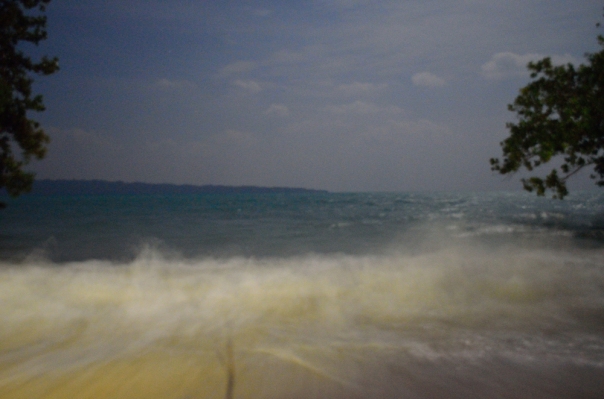
The angry sea at Vijaynagar around midnight. Please visit Flickr for more images

The Vijaynagar Beach during high tide. Please visit Flickr for more images of the region

A live shelled mollusc at the beach. Please visit Flickr for more images of the region

These intricate galaxy-like patterns are produced by sand bubbler crabs as they burrow into the beach

The humble tiny artists use their claws to dig into the beach, sift through the sand and toss the balls behind them
With breathtakingly beautiful silken beaches, lush forested interiors and some of the best diving possibilities in South Asia, the Havelock is a perfect holiday destination to chill out on its sun-toasted beaches. Ever since the Time magazine rated the Radhanagar beach as one of the best beaches in Asia, the tourists flow has been registering an increase with every passing year. With a length of over two kilometres and an average width of 30 to 40 metres, the sandy white beach is indeed very beautiful and worth a visit. Fit for swimming, the beach continues out into the sea as a sandy bottom for nearly 100 metres. While the Kalapathar beach is famous for observing sunrise, the Radhanagar is at its best during a sunset. Most of the resorts are located along the Vijayanagar beach. Approachable either by trekking or through a boat, the Elephant beach is a good site for snorkelling. Both the Vijayanagar and Kalapathar beaches have a rich coral reef formation and an amazing underwater marine life.

The Mahua has a large spreading superficial root system that holds soil together and prevents soil erosion

The unfortunate leftovers of “tourists”. Please visit Flickr for more images of the region
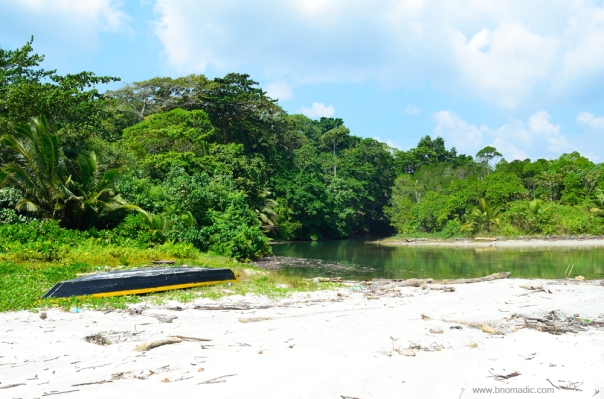
A tidal creek at Havelock. Please visit Flickr for more images of the region

The creek meeting the Andaman Sea. Please visit Flickr for more images of the region
The practical ways to roam around on the island are to rent a scooterette, hire a cab or be on your own. Every morning, I’d leave my room to reach the Kalapathar before the sunrise and come back only after soaking in the magical sundown at the Radhanagar beach. The islands of Andaman are surprisingly bereft of any predatory animal except for saltwater crocodiles. The only animals now found in the islands are wild boars, feral elephants, deer, cows, buffaloes, pigs, cats, goats and dogs. Except for the Great Nicobar, no other island has monkeys. The islands are of course abounded by snakes but not all of them are poisonous. The two creatures that the settlers dread the most after snakes are kankhajura and shark, which throng the seas surrounding the landmasses.
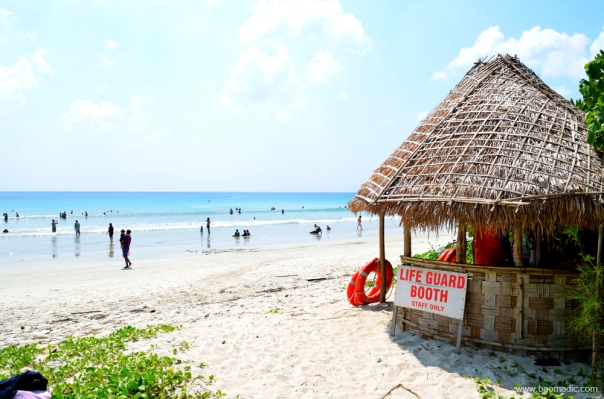
The Radhanagar Beach is the most famous one in the entire Andamans. More images at Flickr

The beach is rated as one of the best in Asia. Please visit Flickr for more images of the region

The calm waters of the Andaman Sea by the sublime silken Radhanagar Beach. More at Flickr

The crescent-shaped white sandy Radhanagar Beach is more than two km long. More images at Flickr

Sundown at the Radhanagar Beach; resets your mood to start afresh. More images at Flickr

How else would one wish to end his day? love and a sunset. More images from the region at Flickr

One of the umpteen moods of the Andaman Sea. Please visit Flickr for more images of the region
Even though, thronged by tourists in large numbers and little affected by the tsunami of 2004, the Havelock remains to be a natural treasure. Out of the total 572 beautiful islands that together form the Union Territory of Andaman and Nicobar Islands, 368 landmasses are, in fact, isles or rocks propping out of the water surface. Most of the islands of the Andamans are uninhabited, out of bound for tourists and are veiled in mystery. These islands are listed among the tropical, evergreen forests of the world. And true to its character, such a wealth of lushness, such a unique combination of aquamarine and emerald, such a dreamy place doesn’t exist elsewhere in India. Elsewhere seasons change, trees shed their leaves; but the islands remain clothed in green all through the year. It won’t be uncommon to notice old leaves on one branch, new leaves on the other; blossoms on one and fruit on another.

The Radhanagar is one of the best beaches for swimming. More from the region at Flickr
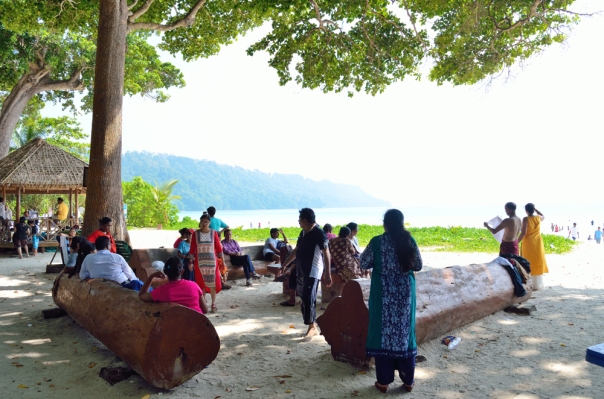
Candids from Havelock; most tourists visit Havelock for a day from Port Blair. Radhanagar sees more crowd during noon and early evening.
As I begin to conclude my sojourn at the island, I must admit that the varied aspects of nature that I have seen here – the sandy beaches, the blue water, the hillocks, the glens, the jetties, the canoes and villages, all nestled in the bosom of a vast ocean, which is forever ready to consume the soil and greens of these islands; and observe its many moods – are beyond any comparison. Stretching south of Myanmar to the north of Indonesia, the island spans nearly 800 km from its northernmost tip to southernmost in a bow-shaped manner. Many geologists believe that a submerged mountain range stretches from Myanmar to Indonesia and the visible upper parts of the range form the Andaman and Nicobar Islands. Adding to the intrigue is its remote location: some 1400 km from the Indian mainland or just 150km from Indonesia and 190km from Myanmar.
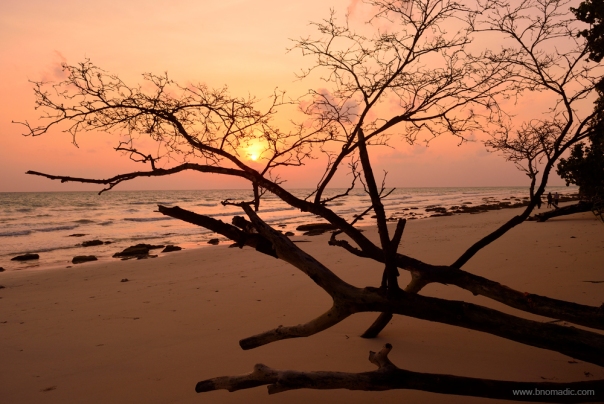
Catching the morning rays at Kalapathar beach, Havelock Island. Please visit Flickr for more images

The lure of faraway islands. Please visit Flickr for more images of the region

Dawn by the Andaman Sea; a perfect oceanside getaway. As the corals around the island are in patches, soil erosion is common. Please visit Flickr for more images

Pandanus groves by the Kalapathar beach. Big trees often succumb to high tide erosion. A number of trees can almost always be seen leaning on the sea and they finally succumb to it. Please visit Flickr for more images

The morning moods of the Kalapathar beach. Please visit Flickr for more images of the region
The return voyage to Port Blair, nearly 50 km on sea route is, however, smooth as a breeze. Chopping the white waves, our vessel is making a steady progress on the surface of dark blue water. There aren’t any birds; only the vastness of the sea. The texture and curls of waves presents myriad patterns. The sun unobtrusively glitters on the water surface making it appear like molten metal instead. With the calmness around, just like the passengers, the catamaran crew heaves a sigh of relief as we are midway our hour-and-a-half-long journey. Michael, a young sailor who hails from Chowra tells me that he always aimed to be a captain of a ship and is still struggling to be one. He doesn’t want to discuss about the tsunami of 2004 but tells me that settlers and natives of Andamans still shudder in fear while talking of the natural disaster that affected almost every living creature in the islands. Apart from the tsunami of 2004 that consumed over 7,000 recorded lives in the islands, the period that Andamans would definitely want to forget are the century-long hold of the British as well as the three years of the Japanese occupation – a virtual reign of terror – that had wiped out almost 45 per cent of the then population of the islands.

The crowd awaiting the arrival of ferry at the Havelock Jetty. More images from the region at Flickr
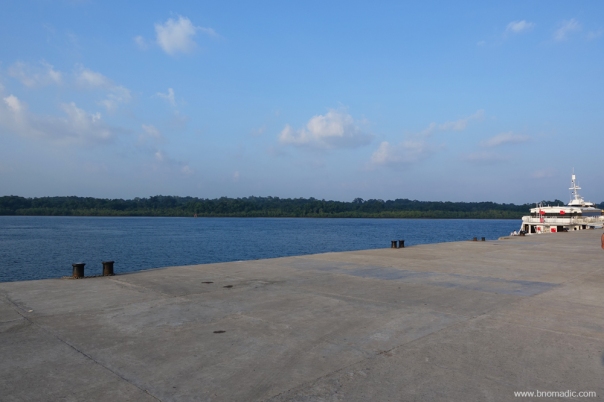
The Havelock Jetty and the calm waters of the Andaman Sea; the landmass in front is Sir William Peel Island
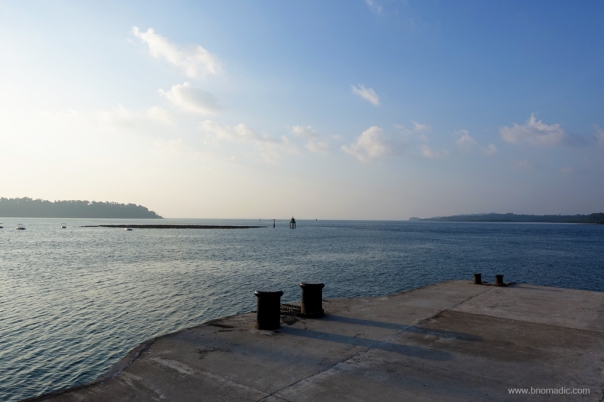
The Havelock Jetty; the small concrete protrusion in the waters is to warn the ships of the fragile coral reefs
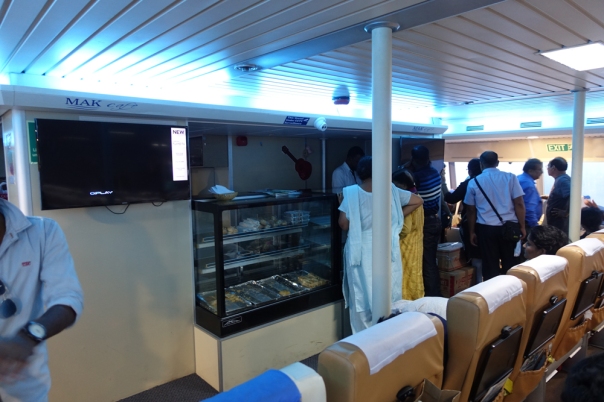
The empty snacks counter inside the ferry. Please visit Flickr for more images of the region

Sailing back to Port Blair. Please visit Flickr for more images of the region

Say Hello to Dolphins! Please visit Flickr for more images of the region
Getting There
The most practical way of reaching the beach paradise of the Havelock Island is through the sea route. Weather permitting; ferries take about 1.5 to 3 hours in reaching Havelock Jetty through the Phoenix Bay Jetty of Port Blair. The catamaran operated by privately managed Makruz is the quickest as well as most comfortable option to reach the island from Port Blair. The DSS managed government ferries take about 2.5 to 3 hours in covering the same distance. The ferry schedule takes a hit every year during monsoons.
Otherwise, you need to be really lucky to manage a seat in the privately managed helicopter services. The sea plane service too has nearly been a nonstarter on this route. Whichever option you may prefer, always book well in advance and remain aware that the timings too are often changed without prior announcement.
Best time to visit: Any time of the year except monsoons
Travel Lure: Beaches and Marine life
Accommodation: Available but always confirm in advance
 bNomadic
bNomadic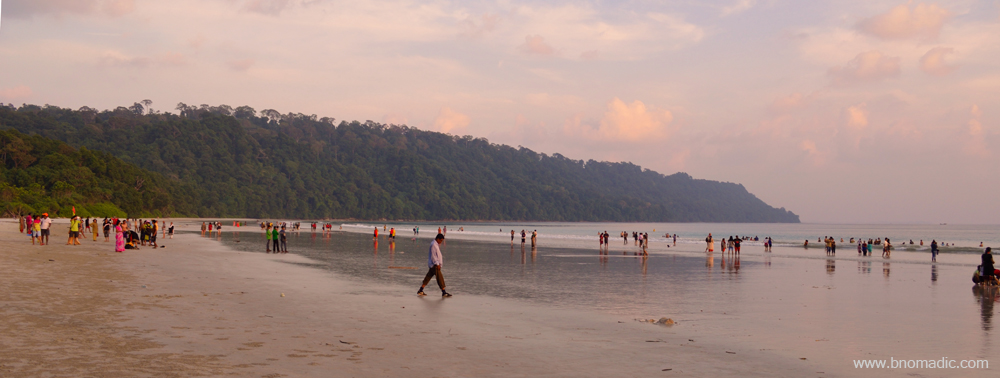








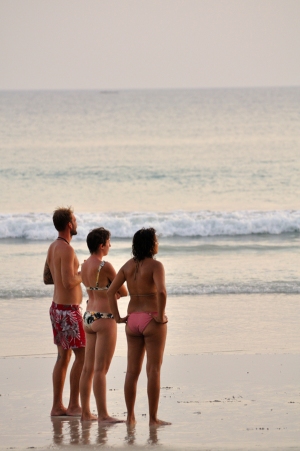



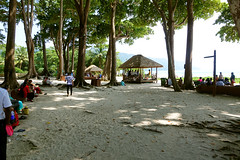






fabulous fantastic beautiful place thanks for sharing your travel diary with us
Thanks Pushpendra for stopping by the blog! Hope you liked the story as well. Keep visiting bNomadic for more such travel stories 😊💐
Beautiful pictures 👍
Thanks Sachin! Keep visiting bNomadic for more such travel stories 😊💐
Thanks to the writeup and some excellent photographs, this post brings some very pleasant memories back.
O really! I totally understand and know your feelings. The place has every reason to feel nostalgic 😊💐 Keep visiting bNomadic